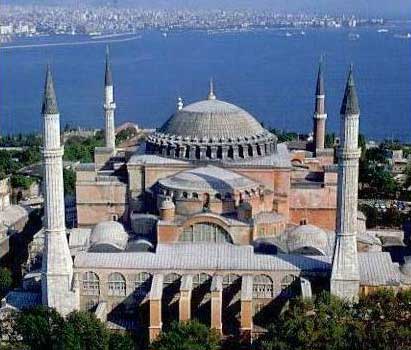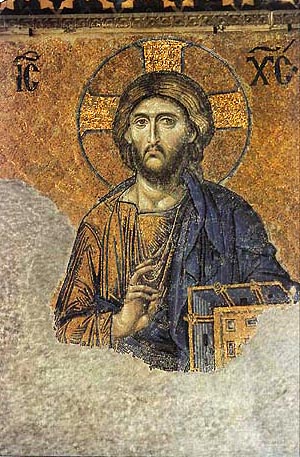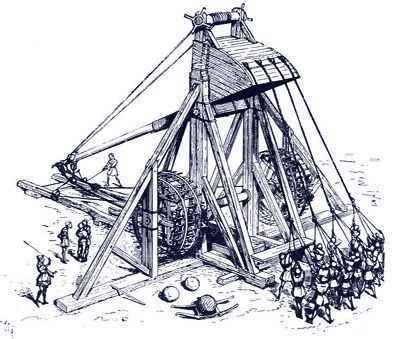The Byzantine Empire
(The Byzantine Empire areas of control)
G - The Byzantine Empire is located between Eastern Europe nad the Middle East with extraneous regions located in North Africa and Southern Russia. The empire is surrounded by the Aegean Sea, the Black Sea, the Gulf of Cyprus, and the Caspian Sea. With its strategic location, the Byzantine Empire became a center of trade, commerce, and high culture.
(Another photo of the Byzantine Empire. Distinguishes all the major trading cities that were under the Byzantine Control).
R - The religion of the Byzantines was Christianity. The Byzantines often viewed their Emperor as a representative or messenger of Christ. Along with their beliefs, the Emperors built many elaborate, gigantic churches and places of worship. The Church of Constantinople became the richest and most influential center of Christianity during the Empires reign. (Located below is the Church of Constantinople).

A - The Byzantine's artwork was primarily religious based. More specifically, the art tried to translate the church's theological views into artistic pictures and interpretations. The art was spread throughout Europe, but had a major impact of influence in the Italian Renaissance. Along with art, the Byzantine architecture was solely based on religion as well. Like the Church of Constantinople, many other churches and places of worship were erected. Lastly, the Byzantine Empire wrote many stylistically, and culturally different pieces of literature. Drawing from four different cultural backgrounds, the Greek, the Christians, the Romans, and the more Oriental Eastern Eurasia elements, their literature reflected the aspects and many historical events. Coming from many different cultural groups, the Byzantines created two new types of writing. One being ecclesiastical, and the other being popular historical theology poetry. Of all the literature that was written, there are about two to three thousand volumes of writings, and a couple hundred volumes of secular poetry, history, science and pseudo-science.
 (This is the most famous of the remaining mosaics from the Byzantine Empire. It is a representation of Jesus).
(This is the most famous of the remaining mosaics from the Byzantine Empire. It is a representation of Jesus).
S - The Social Developments of the Byzantines were very religiously based. The population believed in certain rituals and prayers to further benefit people.
P - The Byzantine Empire's politics were patriarchy based. The Emperor became the sole and absolute ruler, and his power was regarded from divine origin. Although the Byzantine's had a Senate, they possessed few to no legislative authority. Later in the 6th century, Court Officials were arranged in strict order to watch over and guide the emperor in his decision making.
 (This is Constantine the Great. One of the many great Emperors of the Byzantine Empire).
(This is Constantine the Great. One of the many great Emperors of the Byzantine Empire).
E - The Byzantine economy was one of the greatest and most advanced in Eurasia at the time. The Byzantine Empire had most of the trading post cities under control. The cities were: Constantinople, Alexandria, and Tripoli. Among the many traded goods and services that were exchanged, the Byzantine's major income came from agriculture. The Byzantine's produced: wheat, vegetables, fruit, silk, and barley.
 (Byzantine coins)
(Byzantine coins)
D - At the height of the Byzantine Empire, there was roughly 26 million inhabitants.
I - The Intellectual Developments that occurred during the Byzantine Empire dealt with local humanistic concerns. The Byzantines wrote and expressed concerns about salvation, territorial disputes, the Black Death, lack of education outside of monasteries, and small-scale trade.
T - The Byzantines invented many new items. Dealing with architecture, the Cross-in-square was created. This was a certain design for churches, and the Church of Constantinople was built in this fashion. Another architectural invention was the Pendentive dome. This was a circular dome that was to be built on top of the Cross-in-square. Once again, this can be seen on the Church of Constantinople. Dealing with battle and warfare inventions, the Byzantines created the Counterweight trebuchet. This was a very powerful weapon described as a stone projector equipped with a windlass, and an apparatus required to launch projectiles. Along with the counterweight trebuchet, they also created the hand trebuchet. With close contact, the Byzantines invented Greek-fire, a fire that does not diminish with the addition of water, grenades, and flamethrowers (connected to the trebuchets.)
 (This is a Byzantine counterweight trebuchet).
(This is a Byzantine counterweight trebuchet).

No comments:
Post a Comment